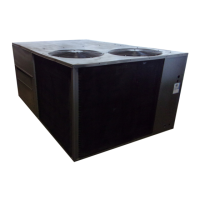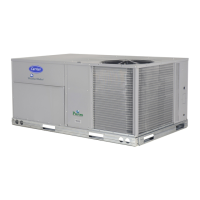ENTHALPY SWITCH/RECEIVER -- The accessory en-
thalpy switch/receiver (33CSENTHSW) senses temperature
and humidity of the air surrounding the device and calculates
the enthalpy when used without tin enthtdpy sensol: The relay is
energized when enthalpy is high and deenergized when
enthalpy is low (based on ASHRAE [American Society of
Heating, Refiigerafion and Air Conditioning Engineersl 90.1
criteria). If an accessory enthalpy sensor (33CSENTSEN) is
attached to the return air sensor input, then differential enthalpy
is ctdculatedi The relay is energized when the enthalpy detected
by the return air enthalpy sensor is less than the enthtdpy at the
enthalpy switch/receivel: The relay is deenergized when the
enthalpy detected by the return air enthalpy sensor is greater
than the enthalpy at the enthalpy switch/receiver (differential
enthtdpy control). See Fig. 21 and 22.
OUTDOOR ENTHALPY CONTROL (Fig. 23) -- Outdoor
enthalpy control requires only tin enthalpy switch/receiver
(33CSENTHSW). The enthalpy switch/receiver is mounted in
the outdoor air inlet and calculates outdoor air enthalpy. The
enthalpy switch/receiver energizes the relay output when the
outdoor enthalpy is above 28 Btu/lb OR din bulb temperature
is above 75 F and is deenergized when file outdoor enthalpy is
below 27 Btu/lb AND dU bulb temperature is below 74.5 E
The relay output is wired to the unit economizer which will
open or close depending on the output of the switch.
NOTE: The enthalpy calculation is done using tin average
altitude of 1000 ft above sea level.
Mounting -- Mount the enthalpy switch/receiver in a location
where the outdoor air can be sampled (such as the outdoor air
intt&e). The enthtdpy switchheceiver is not a NEMA 4
(National Electrical Manufacturers Association) enclosure and
should be mounted in a location that is not exposed to outdoor
elements such as rain or snow. Use two field-supplied no. 8 x
3/4-in. TEK screws. Insert the screws through the holes in the
sides of the enthalpy switch/receivel:
Wiring -- Carrier recommends the use of 18 to 22 AWG
(American Wire Gage) twisted pair or shielded cable for all
wiring. All connections must be made with l/4-in, female spade
connectors.
A 24-vac transformer is required to power the enthtdpy
switch/receiver; as shown in Fig. 23, the PremierLink TM board
provides 24 vac. Connect the GND and 24 VAC temrinals on
the enthalpy switch/receiver to the termimfls on the transform-
el: On some applications, the power fi_m the economizer har-
ness can be used to power the enthalpy switch/receivec To
power the enthalpy switch/receiver from the economizer har-
ness, connect power of the enthalpy switch/receiver to the red
and brown wires (1 and 4) on the economizer harness.
For connection to roollop units with PremierLink control,
connect the LOW Enthalpy terminal on the enthalpy switch/re-
ceiver to J4 -- pin 2 of the PremierLink control on the HVAC
unit. The switch can be powered through the PremierLink con-
trol board if desired. Wire file 24 VAC terminal on file enthalpy
switchheceiver to J4 -- pin 1on the PremierLink control. Wire
the GND termimd on file enthalpy switch/receiver to Jl --
pin 2 on the PremierLink control. The HI Enthalpy terminal is
not used. See Fig. 23.
25"-,--
(8 35ram)
ulb_
+'4"4
4253"
(108 03ram)
IP
into
Thermistor --_ S Humidity Sensor
Fig. 21 -- Enthalpy Switch/Receiver Dimensions
(33CSENTHSW)
25'*- --
(6 35rnm)
4253"
(I 08 03turn)
¢to 3OmA
375"
(95 25rnm)
Thermistor -_
IJ,
c_ _o
S HurnMity Sensor
N_
Fig. 22 -- Enthalpy Sensor Dimensions
(33CSENTSEN)
15

